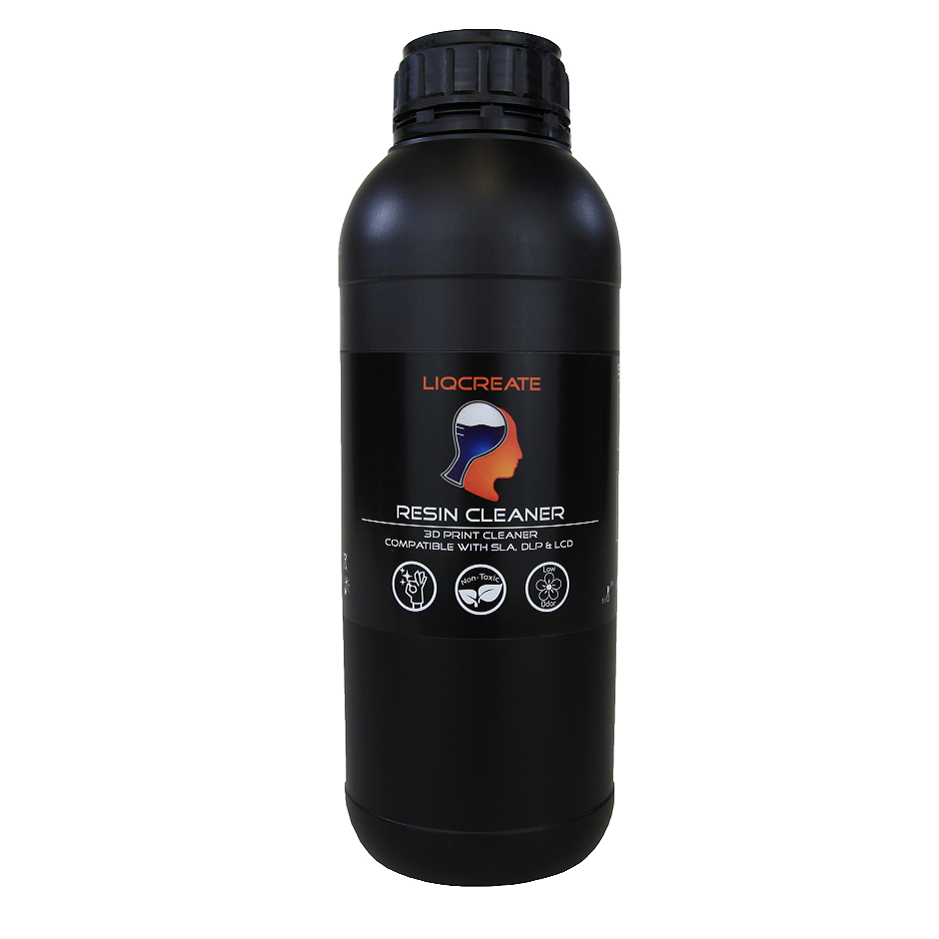Team Liqcreate would like to thank Kerry Stevenson and Fabbaloo for writing about non-toxic resin cleaning solutions.. The article has not been modified and the original article by Fabbaloo can be found here.

Cleaning 3D printer resin is often a messy task, and one that’s made more difficult with “dangerous” cleaners. What are the alternatives?
It turns out there are a few options. If you’re not familiar with the concept of cleaning resin 3D-printing parts, please let me explain. This is a process that must take place on every resin 3D-printed part. These processes use liquid photopolymer resin material. Resin is designed to solidify when exposed to a particular light wavelength. Typically this is 385nm or 405nm, delivered by laser, DLP projector or LCD screen. This process allows for the 3D printing of extremely high resolution models, depending on the resolution of the light masking method / laser spot. There are many different types of photopolymer resin to provide different properties. For example, you can use resin that 3D prints completely transparent, or resin that can withstand high temperatures when solidified.
Cleaning of your resin 3Dprinted parts.
But all of them have one challenge: the resin sticks to the sides of the fresh print when the job completes. The parthas been repeatedly dipped into a vat of the photopolymer resin during printing. When the 3D-printing process is finished resin sticks to all sides of the parts. Oh, it’s an easy solution: just wipe it off.
Although, it’s not that easy. It turns out that the photopolymer resin is sometimes toxic (learn more about the differences and severity of toxicity of resins here). For most resins a well ventilated area and wearing gloves to touch the non-cured part is advised. This is glove territory, folks. You must remove the liquid resin. That’s because the print will undergo a final curing stage, typically being left in a UV-light bath for a time, or even left on a windowsill in the sunlight. Any stray resin will solidify and create blobs and solid drips on your print. It’s very important to remove every drop of liquid resin. Also semi-washed alcohol-resin spots can leave a white residue on the printed part after curing.
The usual method of resin cleaning is through IPA, or isopropyl alcohol. This solvent is easily obtained anywhere, and does a very good job dissolving 3D-printing resin. The drops are soluble in IPA, which eventually turn it from a clear liquid to a discolored fluid after many prints have passed through. Cleaning works especially well if the IPA is actively circulated, a feature usually found in resin cleaning station equipment.
Although there are a couple of challenges. IPA is not exactly a safe material, although it is commonly available. It is flammable, and cannot be taken internally. Kerry Stevenson says “I don’t know about you, but I am not comfortable with the notion of keeping a large vat of flammable fluid sitting in my workshop. It’s also become more challenging to source IPA these days, given its frequent use as a disinfectant during the pandemic.”
Is there an alternative? Yes, it turns out there are several.
Some say acetone is a usable cleaner, but it’s probably even more dangerous to handle than IPA, so let’s discard that option. Comment from Liqcreate: Too long soaking in Acetone can also deminish material properties and give unwanted warpage to parts.
Thats why here at Liqcreate we developed::
Liqcreate’s Resin Cleaner
“Liqcreate Resin Cleaner is an excellent, effective non-toxic post-print cleaning solution for 3D printing. It is a safe, highly effective cleans faster than other cleaner liquids based on IPA, bio-ethanol and other chemicals. Liqcreate Resin Cleaner is not a dangerous good, non-flammable and has no unpleasant odor.” This is available for €12.39 (US$15) per kg, or €60 (US$71) for 5kg.
Bradley Systems’ Yellow Magic 7
“Our Yellow Magic 7 cleaner was formulated as a flexo UV ink and varnish cleaner for printing human and pet food packaging. For some time now, we’ve been hearing from customers who have found it works well for another application: cleaning parts on SLA 3D printers.” Evidently Bradley Systems created this product for other industrial purposes, but then learned it was being used by 3D printer operators. They’ve since provided some advice on how best to use it for that purpose. Yellow Magic 7 is currently sold out these days but appears to be priced at under US$30 for a one gallon jug (3.8L).
Hero Wash 3D Print Cleaner
“HERO Wash is an alternative to Isopropyl Alcohol IPA. HERO WASH removes uncured Photopolymer Resin from your 3D Resin Prints. HERO WASH is a general UV cleaner for in and around your workspace as well.” Hero Wash is available for US$15 for 1L, or US$65 for 5L.
In addition to these 3D print specialized cleaners, it is also possible to use various household general cleaning solutions. Some that are typically used by 3D printer operators include Simple Green or Mr. Clean. These are widely available at low prices, but results may vary as they were not designed for this purpose.
Finally, it’s also possible to mix combinations of these materials together. There are many reports of experiments with IPA being mixed with other solvents, usually in an attempt to reduce the overall cost of cleaning. However, results may have differing levels of quality and some chemicals should not be mixed with each other. Please be extremely careful if doing such experiments.
Selecting a cleaning solution for your resin 3D printing needs depends on a number of factors, including your workshop environment, budget, safety tolerance and print quality needs. There seems to be many choices for any situation.